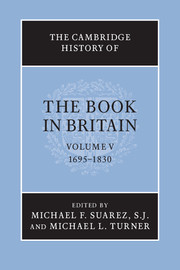Book contents
- Frontmatter
- Introduction
- PART I THE QUANTITY AND NATURE OF PRINTED MATTER
- PART II ECONOMIC, LEGAL AND CULTURAL CONTEXTS
- PART III THE TECHNOLOGIES AND AESTHETICS OF BOOK PRODUCTION
- PART IV THE BOOK TRADE AND ITS MARKETS
- I LONDON AND THE ‘COUNTRY’
- 13 London and the central sites of the English book trade
- 14 Personnel within the London book trades: evidence from the Stationers’ Company
- 15 The English provincial book trade: evidence from the British book trade index
- 16 The Scottish book trade
- 17 The Irish trade
- II TWO CASE STUDIES
- III SERIAL PUBLICATION AND THE TRADE
- IV THE INTERNATIONAL MARKET
- V BOOKS AND THEIR READERS
- Abbreviations used in bibliography
- Bibliography
- Index
- Frontispiece
- Plate section
16 - The Scottish book trade
from I - LONDON AND THE ‘COUNTRY’
Published online by Cambridge University Press: 28 September 2010
- Frontmatter
- Introduction
- PART I THE QUANTITY AND NATURE OF PRINTED MATTER
- PART II ECONOMIC, LEGAL AND CULTURAL CONTEXTS
- PART III THE TECHNOLOGIES AND AESTHETICS OF BOOK PRODUCTION
- PART IV THE BOOK TRADE AND ITS MARKETS
- I LONDON AND THE ‘COUNTRY’
- 13 London and the central sites of the English book trade
- 14 Personnel within the London book trades: evidence from the Stationers’ Company
- 15 The English provincial book trade: evidence from the British book trade index
- 16 The Scottish book trade
- 17 The Irish trade
- II TWO CASE STUDIES
- III SERIAL PUBLICATION AND THE TRADE
- IV THE INTERNATIONAL MARKET
- V BOOKS AND THEIR READERS
- Abbreviations used in bibliography
- Bibliography
- Index
- Frontispiece
- Plate section
Summary
Scotland had not been subject to the same form of official control of its printing as England, yet in 1700 its book trade was small – a press at Aberdeen, another at Glasgow, a half-dozen printing establishments in Edinburgh, and some booksellers in the major centres and a few country places – comprising perhaps fewer than ninety workers for a population of a million. There were probably six paper mills. By the early nineteenth century, booksellers and printers had set up business in many of the smaller towns, and Scotland had printing, publishing and paper industries operating on a British scale. This enlarged trade can be viewed against a broader social and economic context. Scotland manifested many of the features of a ‘traditional underdeveloped economy’ at the end of the seventeenth century, but the following eighty years or so witnessed, particularly after mid-century, a more stabilized political and economic climate and significant commercial and trading developments, such as the tobacco trade and the banking system. Employment opportunities became more varied; personal incomes increased, contributing to a heightened demand for commodities, and many Scots had more comfortable lifestyles. In consequence, readers, including tradesmen and artisans, acquired books printed domestically and imported from London and elsewhere. The Union of 1707 gave Scotland access to English markets at home and in the colonies without payment of customs duties, and classed Scottish vessels as British, bringing privileges and protection. In 1710 came the Copyright Act of 8 Anne; by mid-century, these opportunities enabled the Scots to have a sizeable book export trade and a growing reprint industry.
Keywords
- Type
- Chapter
- Information
- The Cambridge History of the Book in Britain , pp. 352 - 365Publisher: Cambridge University PressPrint publication year: 2009
- 1
- Cited by



